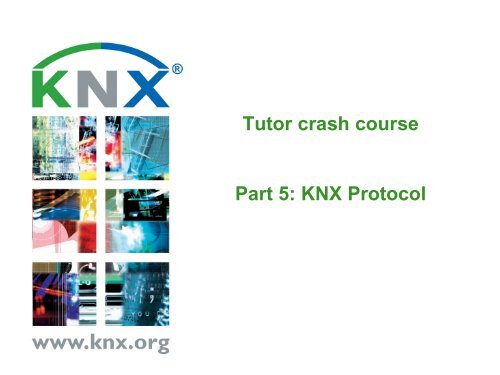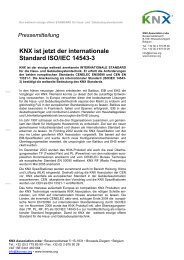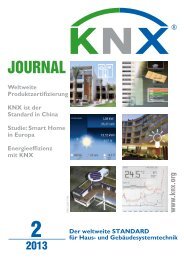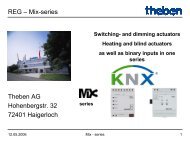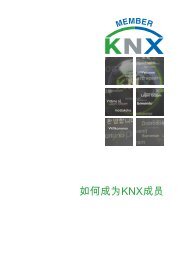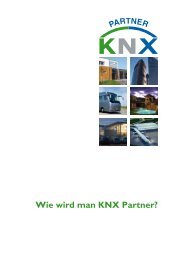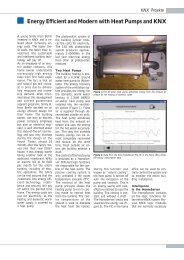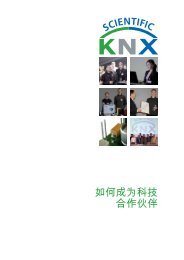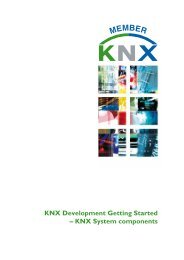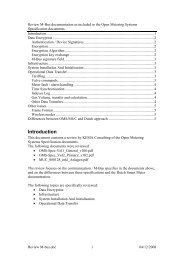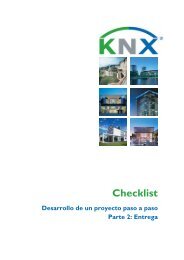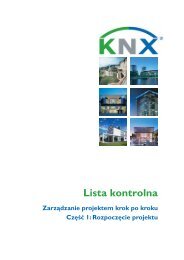Presentation - KNX
Presentation - KNX
Presentation - KNX
Create successful ePaper yourself
Turn your PDF publications into a flip-book with our unique Google optimized e-Paper software.
Tutor crash course<br />
Part 5: <strong>KNX</strong> Protocol
<strong>KNX</strong> Protocol: hierarchical classification of bus systems<br />
• Field level<br />
• Sensor/actuator level<br />
• Small data throughput – time<br />
critical<br />
• Typical <strong>KNX</strong><br />
• Process level<br />
• Centralised devices monitoring<br />
sensors and controlling actuators<br />
(e.g. building management<br />
station)<br />
• Operation level<br />
• Centralised computer monitoring<br />
devices at process level<br />
• Large data throughput – not so<br />
time critical<br />
System bus<br />
e.g. Ethernet<br />
Operation<br />
Main<br />
Computer<br />
Process<br />
Process<br />
computer/<br />
Control<br />
Center<br />
Process<br />
computer/<br />
Control<br />
Center<br />
Field<br />
Bus<br />
device<br />
Bus<br />
device<br />
Bus<br />
device<br />
Bus<br />
device<br />
Field bus (e.g. Profibus)<br />
<strong>KNX</strong> Association International <strong>KNX</strong>: The worldwide STANDARD for Home & Building Control<br />
Page No. 2<br />
August 12
<strong>KNX</strong> Protocol: classification of serial bus systems<br />
• Frequency Division<br />
Multiplexing<br />
• More than one device<br />
can access the bus at<br />
one given instance<br />
• Time Division<br />
Multiplexing<br />
• One single device<br />
accesses the bus at<br />
one given instance<br />
- <strong>KNX</strong> TP1 = Carrier<br />
Sense Multiple<br />
Access with<br />
Collision Avoidance<br />
Serial<br />
busses<br />
Frequency Division Multiplexing<br />
(FDM)<br />
One bus device per pair of channels<br />
(bidirectional)<br />
Several bus devices per pair of channels<br />
(need for similar bus access methods as<br />
TDM)<br />
Time Division Multiplexing (TDM)<br />
Controlled bus access<br />
Centralized bus allocation<br />
(Master/Slave)<br />
Decentralized bus allocation (Token<br />
passing, Flying master)<br />
Random bus access<br />
CSMA/CD<br />
CSMA/CA<br />
<strong>KNX</strong> Association International <strong>KNX</strong>: The worldwide STANDARD for Home & Building Control<br />
Page No. 3<br />
August 12
<strong>KNX</strong> Protocol: OSI - Principles<br />
• OSI = Open Systems Interconnection<br />
• Is a standard for modelling/structuring distributed<br />
communication systems<br />
• Does not dictate the development method<br />
• All layers in the device contribute to a part of the sent message<br />
– each layer in the device decodes part of a received message -<br />
similar to peeling layers off an onion<br />
• model consists of seven layers, of which some are not used in<br />
<strong>KNX</strong><br />
<strong>KNX</strong> Association International <strong>KNX</strong>: The worldwide STANDARD for Home & Building Control<br />
Page No. 4<br />
August 12
<strong>KNX</strong> Protocol: types of communication<br />
• Connection oriented<br />
communication<br />
• communication between a maximum<br />
of two devices (point-to-point)<br />
• highly secure communication, not<br />
very bandwidth effective<br />
• Link and Transport Layer<br />
acknowledgements will be visible<br />
• in <strong>KNX</strong>: typically during<br />
configuration of devices (between<br />
ETS and device)<br />
• similar to talking to one single<br />
person and checking after each<br />
question whether he/she understood<br />
the question<br />
<strong>KNX</strong> Association International <strong>KNX</strong>: The worldwide STANDARD for Home & Building Control<br />
Page No. 5<br />
August 12
<strong>KNX</strong> Protocol: types of communication<br />
• Connectionless communication<br />
• communication one to many<br />
(« group or multicast ») or one to all<br />
(« broadcast »)<br />
• very bandwidth effective, not<br />
secure communication (one<br />
common confirmation of reception to<br />
the sent message)<br />
• only Link Layer acknowledgements<br />
will be visible on the bus<br />
• in <strong>KNX</strong> typically after configuration of<br />
devices, i.e. during runtime<br />
• similar to talking to a group of<br />
persons and continuing with next<br />
question if only one person confirms<br />
that he/she understood the question<br />
<strong>KNX</strong> Association International <strong>KNX</strong>: The worldwide STANDARD for Home & Building Control<br />
Page No. 6<br />
August 12
OSI & <strong>KNX</strong> (top down) – Application Layer<br />
• provides mechanisms for communication (group) objects. The<br />
application layer ensures that<br />
• an application program is informed when the value in one of its<br />
communication objects was updated (received telegram) or<br />
• that the OSI <strong>KNX</strong> stack creates a telegram when a value of a<br />
communication object updated by the application program (sent<br />
telegrams)<br />
• In other words : when connected to the application layer, the application<br />
program is unable to retrieve who was the source of the update!!!<br />
• provides mechanisms for management purposes. These services<br />
- as part of the OSI <strong>KNX</strong> stack - ensure that devices understand<br />
configuration commands, e.g. sent by ETS (MemoryRead,<br />
MemoryWrite, ….).<br />
<strong>KNX</strong> Association International <strong>KNX</strong>: The worldwide STANDARD for Home & Building Control<br />
Page No. 7<br />
August 12
OSI & <strong>KNX</strong> : <strong>Presentation</strong> and Session Layer<br />
• (<strong>Presentation</strong> Layer)<br />
• ensures that information is always presented to the application<br />
layer (received telegrams) or transport layer (sending telegrams)<br />
in the right order<br />
• Not needed/available in the OSI <strong>KNX</strong> stack<br />
• (Session Layer)<br />
• ensures that communication can be interrupted for a certain<br />
period of time and resumed (at the point where one interrupted it)<br />
at a later stage<br />
• Not needed/available in the OSI <strong>KNX</strong> stack<br />
<strong>KNX</strong> Association International <strong>KNX</strong>: The worldwide STANDARD for Home & Building Control<br />
Page No. 8<br />
August 12
OSI & <strong>KNX</strong>: Transport Layer connection oriented<br />
• transport layer messages will be visible next to Link Layer<br />
messages - sequence of events<br />
• opening a connection from device A (USB linked to ETS) to<br />
device B (device to be downloaded) : T_Connect<br />
• sending telegram for A to B or vice versa<br />
- A and B send T_Ack when properly received<br />
- A and B send T_Nack when not properly received - will cause a<br />
repetition (maximum 3 times)<br />
- a sequence number is incremented after each data exchange<br />
• closing a connection from device A to B : T_Disconnect - also<br />
automatically when communication partner did not react within 6<br />
seconds<br />
<strong>KNX</strong> Association International <strong>KNX</strong>: The worldwide STANDARD for Home & Building Control<br />
Page No. 9<br />
August 12
TL Connection Oriented<br />
Pos<br />
Sender<br />
TL Connect 1.1.1 to 1.1.2<br />
Message Seq. No. 0<br />
Receiver<br />
TL Ack Message Seq. No. 0<br />
TL Disconnect 1.1.1 to 1.1.2<br />
1.1.1 (ETS)<br />
1.1.2<br />
(Device to be programmed)<br />
Neg<br />
Sender<br />
TL Connect 1.1.1 to 1.1.2<br />
Message Seq. No. 0<br />
Receiver<br />
TL Nack Message Seq. No. 0<br />
Rep Message Seq. No. 0 (max 3)<br />
1.1.1 (ETS)<br />
TL Disconnect 1.1.1 to 1.1.2<br />
1.1.2<br />
(Device to be programmed)<br />
<strong>KNX</strong> Association International <strong>KNX</strong>: The worldwide STANDARD for Home & Building Control<br />
Page No. 10<br />
August 12
TL Connection Oriented<br />
No<br />
Sender<br />
TL Connect 1.1.1 to 1.1.2<br />
Receiver<br />
Message Seq. No. 0<br />
…<br />
Rep Message Seq. No. 0 (max 3)<br />
1.1.1 (ETS)<br />
TL Disconnect 1.1.1 to 1.1.2<br />
1.1.2<br />
(Device to be programmed)<br />
<strong>KNX</strong> Association International <strong>KNX</strong>: The worldwide STANDARD for Home & Building Control<br />
Page No. 11<br />
August 12
OSI & <strong>KNX</strong>: TL connectionless – Network Layer<br />
• Transport Layer connectionless<br />
• (when sending) transport layer ensures that the value of the changed<br />
communication object is sent by the Link Layer with the correct<br />
associated (sending) group address<br />
• (when receiving) transport layer ensures that the value of all<br />
communication objects is updated, to which the received group<br />
address is linked.<br />
• Network Layer (NL)<br />
• Ensures that each sent message contains the routing counter value<br />
as set in EEPROM (in case of BCU1, 10Eh)<br />
• Routing counter value will be decremented when passing through<br />
line/backbone coupler<br />
• Can be 0 (no routing), 1 – 6 (normal routing and decrementing, to be<br />
used by normal applications), 7 (route and do not decrement, to be used<br />
by e.g. ETS)<br />
<strong>KNX</strong> Association International <strong>KNX</strong>: The worldwide STANDARD for Home & Building Control<br />
Page No. 12<br />
August 12
OSI & <strong>KNX</strong>:TP1 Link Layer – error detection techniques<br />
Telegram example: BC 1041 17D0 E1 00 81 xx<br />
• Per character (= 8 bits)<br />
• One start bit before the character<br />
• One stop bit after the character<br />
• One parity bit after the character<br />
• = Vertical parity check<br />
• After all sent bytes<br />
• Checksum Byte : adding all sent bytes and Exor-ing the result – actual value<br />
not shown in above telegram example<br />
• = Horizontal parity check<br />
• Combination of vertical and horizontal parity check = cross<br />
check<br />
<strong>KNX</strong> Association International <strong>KNX</strong>: The worldwide STANDARD for Home & Building Control<br />
Page No. 13<br />
August 12
Cross check in <strong>KNX</strong> TP1<br />
Horizontal Parity<br />
Vertical Parity<br />
Character<br />
Checksum<br />
Start<br />
Stop<br />
Parity<br />
<strong>KNX</strong> Association International <strong>KNX</strong>: The worldwide STANDARD for Home & Building Control<br />
Page No. 14<br />
August 12
Bus access and collision<br />
Request to device to<br />
send 1<br />
Signal shape Bit coding “0”<br />
Listen to bus<br />
No and<br />
wait<br />
Signal shape Bit coding “1”<br />
Bus available ?<br />
yes<br />
Send 1 on bus<br />
Continue with next<br />
bit (if any)<br />
no<br />
Collision (= hearing 0)<br />
yes<br />
Interrupt and set<br />
repetition bit to 0<br />
<strong>KNX</strong> Association International <strong>KNX</strong>: The worldwide STANDARD for Home & Building Control<br />
Page No. 15<br />
August 12
OSI & <strong>KNX</strong>:TP1 Link Layer Control field<br />
Telegram example: BC 1041 17D0 E1 00 81<br />
• Note : all characters are sent on the bus from right to left !<br />
• Control Field (8 bit)<br />
• Structure:<br />
D7 D6 D5 D4 D3 D2 D1 D0<br />
1 0 R 1 P P 0 0<br />
• Bit D0 and D1 : preamble bits, set to value 0 (double active bit, avoids that only one spike is<br />
interpreted as the start of a telegram)<br />
• Bit D2 and D3 : priority (P)<br />
value is determined by the setting in ETS for each communication object – parameter from<br />
AL to LL<br />
Coding selected to allow collision avoidance : Zero value overrides the 1 - in case of two<br />
simultaneous sending devices, the one sending a 1 but hearing a 0 will stop transmission<br />
Possible codings: 00b (system) – 10b (alarm) – 01b (High) – 11b (Low)<br />
• Bit D5 : repetition R<br />
- 1 : not repeated telegram<br />
- 0 : repeated telegram<br />
• Other bits (D4, D6, D7) : set to particular fixed value (i.e. if not this value, invalid LL telegram,<br />
not accepted by LL !)<br />
<strong>KNX</strong> Association International <strong>KNX</strong>: The worldwide STANDARD for Home & Building Control<br />
Page No. 16<br />
August 12
OSI & <strong>KNX</strong>: Link Layer (LL) acknowledgement<br />
LL Acknowledgement: 1 single byte XXh<br />
• If coding CCh = Positive Acknowledgement (LL ACK)<br />
• Confirmation of reception of a LL telegram addressed to a device<br />
• Confirmation that :<br />
- The received telegram was received without any errors and<br />
- The device indeed had the individual address contained as destination address<br />
in the received telegram or<br />
- The device indeed listens to the group address contained as destination address<br />
in the received telegram<br />
• Confirmation is sent simultaneous by all addressed devices – sender only sees one confirmation<br />
– if one device out of a group does not send LL Ack, sender can not detect this!<br />
• If coding = 0Ch Negative Acknowledgement (LL NACK)<br />
• Confirmation that the received telegram was received with errors<br />
• If coding = C0h LL Busy<br />
• Confirmation that the received telegram could not be processed as LL – buffers full<br />
• Owing to chosen coding, in the case of simultaneous sending of ACK and Nack (or Busy), Nack or<br />
Busy overrule ACK – in that case, sender retransmits with repetition flag set (devices having already<br />
processed previous non-repeated telegram, disregard repeated telegrams)<br />
• Across lines, line/backbone couplers take over the Acknowledgement of telegrams<br />
<strong>KNX</strong> Association International <strong>KNX</strong>: The worldwide STANDARD for Home & Building Control<br />
Page No. 17<br />
August 12
Repetition Flag<br />
Sender<br />
GA x<br />
GrpValueWrite Grp x, R=1, Value 1<br />
“GrpValueWrite” Grp x, R=0, Value 1<br />
Receiver 1<br />
GA x<br />
Receiver 2<br />
Ack<br />
GA x<br />
Ack<br />
Receiver n<br />
GA x<br />
Nack<br />
Ack<br />
<strong>KNX</strong> Association International <strong>KNX</strong>: The worldwide STANDARD for Home & Building Control<br />
Page No. 18<br />
August 12
OSI & <strong>KNX</strong>:TP1 Link Layer – further fields<br />
Telegram example: BC 1041 17D0 E1 00 81 xx<br />
• Sender address (format see next slide)<br />
• Individual address of the sending device<br />
• Zero value overrides 1 – in case of two simultaneous sending devices, the one<br />
sending a 1 but hearing a 0 will stop transmission (i.e. at the latest when sending<br />
its individual address, which should be unique).<br />
• Destination address (format see next slide)<br />
– Can be a group address or an individual address<br />
– Depends on the first bit in the byte following the destination address<br />
– When group address = 0/0 then broadcast telegram (message to all devices in the<br />
network)<br />
• N_PDU (Network Protocol Data Unit)<br />
– See later (slide 54)<br />
• Check byte<br />
– See before (slide 45)<br />
<strong>KNX</strong> Association International <strong>KNX</strong>: The worldwide STANDARD for Home & Building Control<br />
Page No. 19<br />
August 12
Format Individual and Group Address<br />
Individual Address (16 bit) = can be sender or destination address<br />
D15 D14 D13 D12 D11 D10 D9 D8 D7 D6 D5 D4 D3 D2 D1 D0<br />
Area<br />
Line<br />
Device address<br />
If value is 0 backbone<br />
If value is 0 main line<br />
If value is 0 coupler<br />
If value is 1 to 15 area<br />
If value is 1 to 15 line<br />
If value is between 1 to 64 first line segment<br />
If above 64: line extension, other line segment<br />
2 level “M/S”<br />
3 level “M/m/S”<br />
Group Address (16 bit) = can only be destination<br />
address<br />
D15 D14 D13 D12 D11 D10 D9 D8 D7 D6 D5 D4 D3 D2 D1 D0 D7<br />
Main Group Subgroup T<br />
Main Group Middle Group Sub Group<br />
Next byte<br />
Most significant bit T= type<br />
…<br />
Most significant bit not used in two level/three level group address structure (only when having<br />
set free address structure in ETS 4)<br />
<strong>KNX</strong> Association International <strong>KNX</strong>: The worldwide STANDARD for Home & Building Control<br />
Page No. 20<br />
August 12
Decoding of <strong>KNX</strong> Telegrams:<br />
summary flowchart (1)<br />
Control field<br />
1 byte<br />
Format see slide 48<br />
Sender<br />
Address<br />
2 bytes<br />
Format individual address<br />
see slide 52<br />
Destination<br />
Address<br />
2 bytes<br />
Individual or group ? see first bit<br />
next byte<br />
Format individual or group address<br />
see slide 52<br />
<strong>KNX</strong> Association International <strong>KNX</strong>: The worldwide STANDARD for Home & Building Control<br />
Page No. 21<br />
August 12
Decoding of <strong>KNX</strong> Telegrams:<br />
summary flowchart (2)<br />
Address Type<br />
1 bit<br />
Group = 1 – Individual = 0<br />
Routing<br />
counter<br />
3 bits<br />
Value of routing counter 0 to 7<br />
Payload length<br />
4 bits<br />
Length of the useful data<br />
<strong>KNX</strong> Association International <strong>KNX</strong>: The worldwide STANDARD for Home & Building Control<br />
Page No. 22<br />
August 12
Decoding of <strong>KNX</strong> Telegrams:<br />
summary flowchart (3)<br />
Type of TL<br />
communication<br />
2 bit<br />
UDP = Unnumbered Data Packet<br />
NDP = Numbered Data Packet<br />
UCB = Unnumbered Control Data<br />
NCD = Numbered Control Data<br />
00b UDP 01b NDP 10b UCD<br />
11b NCD<br />
4 bit<br />
always 0<br />
4 bit<br />
Seq. No<br />
4 bit<br />
always 0<br />
4 bit<br />
Seq. No<br />
4 bit 4 bit<br />
2 bit<br />
2 bit<br />
APCI + rest : see<br />
Manual P 28 till<br />
end of chapter<br />
APCI + rest : see<br />
Manual P 28 till<br />
end of chapter<br />
00b = TL Connect<br />
01b = TL<br />
Disconnect<br />
10b = TL Ack<br />
11b = TL Nack<br />
<strong>KNX</strong> Association International <strong>KNX</strong>: The worldwide STANDARD for Home & Building Control<br />
Page No. 23<br />
August 12
OSI & <strong>KNX</strong>: examples of APCIs<br />
• Group Value Read, Value Write, Value Response respectively used to<br />
• read the value of a communication object linked to a particular group address<br />
• write the value of a communication object linked to a particular group address<br />
• reply to a read request with the value of the communication object linked to the group<br />
address used in the read request (in BCU1 = value write for receiver !!)<br />
• are only visible telegram types in a running and configured <strong>KNX</strong> installation<br />
• Memory Write<br />
• write up to 12 byte in the memory of a bus device starting from the indicated memory<br />
address<br />
• Individual Address Write<br />
• writes the indicated individual address into the device in programming mode<br />
• Authorize Request<br />
• used in BCU2/BIM M112 devices, for which one must be authorized to be able to<br />
write memory<br />
<strong>KNX</strong> Association International <strong>KNX</strong>: The worldwide STANDARD for Home & Building Control<br />
Page No. 24<br />
August 12
OSI & <strong>KNX</strong>: TP1 Physical Layer<br />
• Is responsible for the decoding of bits (as generated normally by a<br />
micro-controller) into physical signals on the medium, to which<br />
the bus device is connected<br />
• In principle PhL can be exchanged without affecting the upper<br />
layers<br />
• Physical Layer also specifies e.g. cable distances, cable<br />
characteristics, ….<br />
• Two types of TP1 cable exists : green (standardised – distances<br />
of PhL ensured) – not green (non-standardised – distances of PhL<br />
not ensured)<br />
<strong>KNX</strong> Association International <strong>KNX</strong>: The worldwide STANDARD for Home & Building Control<br />
Page No. 25<br />
August 12
Summary <strong>KNX</strong> Stack<br />
Note: no Session or<br />
<strong>Presentation</strong> Layer in <strong>KNX</strong><br />
Application<br />
Application Layer<br />
Transport Layer<br />
Grp Objects/Configuration<br />
Management<br />
Conless: AssocTable<br />
ConOr: TL (Dis)Connect/<br />
TL (N)Ack<br />
Network Layer<br />
Link Layer<br />
Physical Layer<br />
Routing<br />
Error Detection<br />
@ Table<br />
CSMA/CA<br />
Digital Analogue<br />
<strong>KNX</strong> Association International <strong>KNX</strong>: The worldwide STANDARD for Home & Building Control<br />
Page No. 26<br />
August 12
OSI & <strong>KNX</strong>: Practical Exercises (1)<br />
Decode the control field in the underneath telegram<br />
(1) 90 1041 17D0 E2 00 80 42<br />
Is the underneath telegram a valid frame?<br />
(2) 24 1041 0001 E1 00 80<br />
<strong>KNX</strong> Association International <strong>KNX</strong>: The worldwide STANDARD for Home & Building Control<br />
Page No. 27<br />
August 12
OSI & <strong>KNX</strong>: Practical Exercises (2)<br />
Decode the destination address in the underneath telegram<br />
(3) BC 1041 50F4 E4 00 80 1C 0C 01<br />
What type of telegram is this?<br />
(4) CC<br />
<strong>KNX</strong> Association International <strong>KNX</strong>: The worldwide STANDARD for Home & Building Control<br />
Page No. 28<br />
August 12
OSI & <strong>KNX</strong>: Practical Exercises (3)<br />
What value does the routing counter have in the underneath frame?<br />
(5) BC 1041 17D0 B3 00 80 05 78<br />
What is the significance of the bytes after the destination address?<br />
(6) 94 1041 1234 30 FF<br />
<strong>KNX</strong> Association International <strong>KNX</strong>: The worldwide STANDARD for Home & Building Control<br />
Page No. 29<br />
August 12
OSI & <strong>KNX</strong>: Practical Exercises (4)<br />
What is the significance of the bytes after the destination address?<br />
(7) B4 1041 1234 51 43 00<br />
What is the significance of the bytes after the destination address?<br />
(8) BC 1041 38CA BF 00 40 49 27 6D 20 6B 6E 61 63 6B 65<br />
72 65 64 00<br />
<strong>KNX</strong> Association International <strong>KNX</strong>: The worldwide STANDARD for Home & Building Control<br />
Page No. 30<br />
August 12
Thank you for your<br />
attention and good luck at<br />
the exam!!


